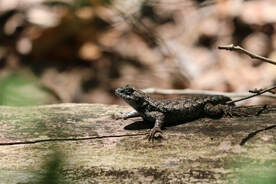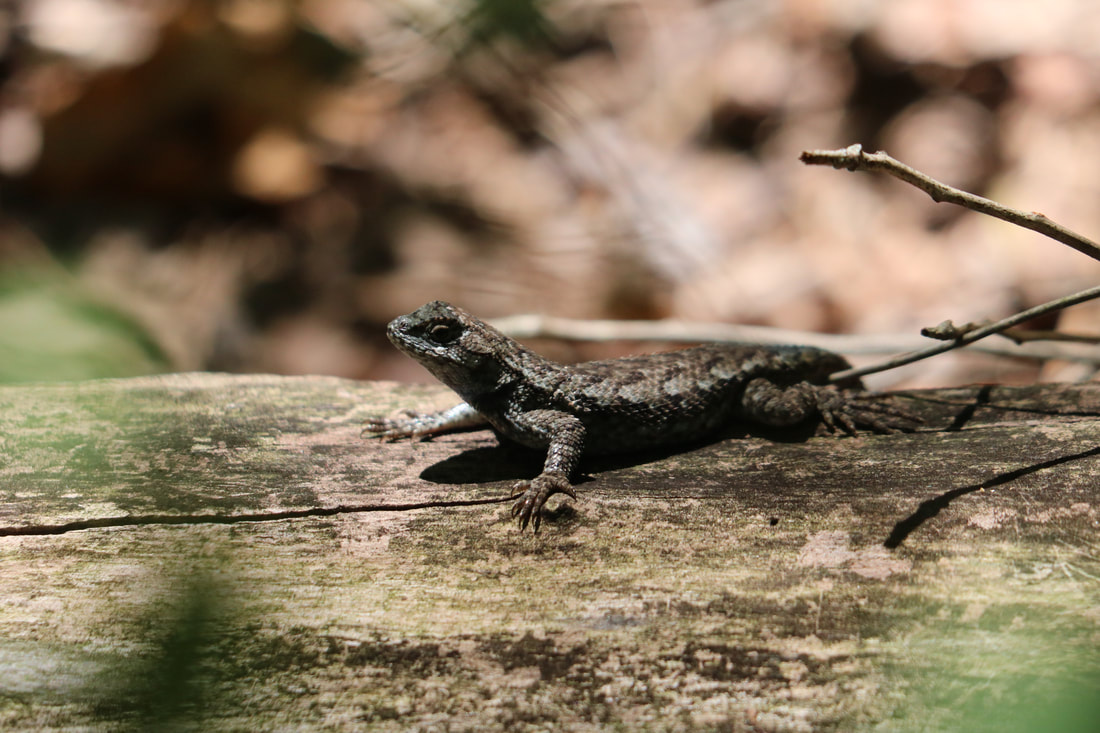
Cloudland Canyon State Park, near Trenton, Georgia provides excellent opportunities for nature appreciation, photography, and writing. I visited on Sunday, July 26 and again on Tuesday, August 4. The park was crowded on Sunday, and about half were wearing masks. I kept my distance from the crowds. On Tuesday, I encountered very few people, although the campground was full. There is a modest parking fee of $5.00 per vehicle, but I bought a season pass, discounted for senior citizens.
I encountered the fence lizard, the diminutive dragon which I have adopted as my mascot for now, as I returned from Overlook Number One, I stepped off the trail to let an oncoming group pass. The rocky ground was bare and provided an opening within the surrounding forest. When I looked to my left, there he was, perched on a fallen log.
I say he, but I don’t know the lizard’s gender. Males have a blue belly which they flash as part of their courtship display. They also do pushups, lifting and lowering their bodies on the forelegs, as a courtship signal to females and a territorial announcement to other males. Presumably, a female lizard somehow assesses his suitability from this display, just as a female bird can assess a singing male’s genetic fitness, hunting ability, and overall desirability from the song.
Female fence lizards have white bellies, but I did not see this lizard’s belly. The lizard did not move. By instinct, the lizard remained frozen with camouflage as the main protection from me, perhaps a potential predator.
I slipped my cameral into action, taking a “grab shot” with the lens at 89 millimeters. Then I zoomed the lens out to its 300 mm maximum length and snapped several shots.
I don/t know if anyone passed on the trail behind me or if any other animals happened by at the time. There was only the camera, the lizard and me. The lizard may have slipped into the brush as I turned and left.
Resources for Nature Writing
“The Greatest Nature Essay Ever,” published in Orion magazine, is Brian Doyle’s contribution to the art of essay writing. During his lifetime, Doyle published at least one collection of essays, as well as nonfiction nature books and fictional works with nature settings.
Barry Lopez, also the author of nature works in several genres and winner of the National Book Award, is an excellent source of exemplary nature writing. Read his essay “The Naturalist,” in Orion magazine.
I believe Orion is currently the best exemplary journal for prose nature writing, but the Tennessee Conservationist is an excellent place to read exemplary nature journalism.
Mary Oliver’s book Upstream includes exemplary nature essays. Her nature poetry is also well worth a read. Her poem “Wild Geese” is an exemplary nature poem.
Review
The Outermost House
Henry Beston, 1928
Reviewed by Ray Zimmerman
The through the seasons approach is popular among nature writers from Aldo Leopold (A Sand County Almanac) to David George Haskell (The Forest Unseen). Although Beston starts with this approach, he adds a few twists. The bulk of the material is devoted to the fall and winter seasons, and on Cape Cod at that.
He devotes a substantial portion of his descriptions to bird life. My favorites appear in Chapter IX, "The Year at High Tide," the summer chapter. Though one of the shortest chapters, it includes a vivid description of the Common Terns nesting on the beach and attacking interlopers. These include a female Marsh Hawk, likely rearing young of her own. A description of the Least Tern, now endangered, rounds out descriptions of bird life. He opens chapter IX with a description on the olfactory delights of the beach. His words rival descriptions of the benefits of aromatherapy.
Beston also devotes portions of the book to the "Surfmen," Coast Guard personnel assigned to the shore stations and dedicated to finding shipwrecks and rescuing the victims. These hardy men were heirs to those in the United States Lifesaving Service, an agency merged with the Revenue Cutter Service to create the modern Coast Guard. The surfman no longer walk the beach, having been replaced by helicopters and technology, and receive scant notice in history.
Beston concludes his book with the rising of Orion on the morning dunes; the reappearance of his old friends Rigel and Betelgeuse. This is a fitting end to a great book from an all but forgotten literary naturalist
Excerpt from the Book
So runs, as far as it is possible to reconstruct it in general terms, the geological history of Cape Cod. The east and west arm of the peninsula is a buried area of the ancient plain, the forearm, the glaciated fragment of a coast. The peninsula stands farther out to sea than any other portion of the Atlantic coast of the United States; it is the outermost of outer shores. Thundering in against the cliff, the ocean here encounters the last defiant bulwark of two worlds.
Shameless Self Promotion
Several months ago, my article about Chattanooga poetry opportunities appeared in The Chattanooga Pulse.
http://www.chattanoogapulse.com/features/chatty-on-the-mic/

 RSS Feed
RSS Feed